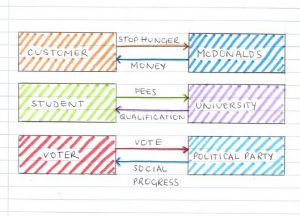What did we cover?
We have moved onto the next module of the CIM course (the marketing module), and begun by exploring the definition of marketing, the function of it and the role it plays within a business.
Marketing defined
A main concept of marketing lies with the idea that marketing is the management of an exchange process, we exchange our goods whether it be money, products, ideas and beliefs for non-profit organisations. This idea can be demonstrated in the diagram below.
Let’s talk about marketing as business philosophy. Marketing plays a crucial role in a business, and the perception of marketing as a business philosophy is definitely one I would consider true. Marketing is where customers stem from and would certainly be considered a fundamental in most businesses.
In the lesson we talked about how marketing is a catalyst for change. This means that marketing sparks an action for change and marketers should be able to respond dynamically because we are working in a fast pace environment where in order to keep up, we must adapt.
‘Marketing is management process responsibility for identifying, anticipating and satisfying customer requirements profitability’ – CIM
Marketing is often perceived as a management process – yet, CIM explain that it is not only managers that do it. It’s more about understanding that marketing handles the responsibility for ensuring that we recognise customer needs as they need them, and quite often identifying the customer needs before they need them. A good example of this would be car air bags. Volvo identified that safety would be a major focus in the future of that industry and were able to introduce air bags at an early stage.
Product sustainability in marketing, is how we satisfy customers and a good product will meet a customer’s needs and expectations. The last aspect of CIM’s definition of marketing to explain is probability, it all comes down to making money, and our end goal of marketing is effectively to turn prospects into happy customers.
Key terms and useful definitions
Differentiation – this is about making sure that your product/ service has unique features, that will help it to stand out aside from the other products in the market
Segmentation – dividing your target audience into individual segments who share common characteristics, the process of segmentation allows you to give more relevant content to your customers (e.g. we have a segmented newsletter that contain different topics, this lets people sign-up to more related news)
Targeting – the process of using segmented groups of your target audience to serve better content to prospects/ customers</span>
Direct marketing – a combination of advertising using computer technology to directly reach out to prospects or customers, this includes email marketing
Relationship marketing – marketing shouldn’t just aim to acquire customers, it should also be used to retain existing customers, relationship marketing is the term used for the on-going relationship with the customer
Social marketing – over recent years marketing has grown and now covers more than just the traditional channels, there are now government agencies that are trying to implement people attitudes to specific issues such as healthy eating or anti-smoking campaigns – this is social marketing, campaigns which aim to promote social well-being
Market orientation – the focus on identifying and satisfying customer requirements is known as market orientation
Company orientation
Orientation means relative position, in this context it means how a company views the relationship with their customers. There are a few different views when it comes to business drive, below are some of the ways that a business may see themselves relative to the market they are in:
- Product orientation – the company are high advocates of their product, they believe that their product is the best out there. The problem with this view is that the company will invest a lot of their money into the manufacturing of the product and do this because they have assumed that people will want to buy the ‘best’ product in the market.
- Production orientation – making the cheapest product there is may appeal to some people… but it is not always the best approach. Some companies will put a lot of time and effort into producing the cheapest product on the market to maximise profits. The major flaw here is obvious, you will potentially lose customer over low-quality items.
- Sales orientation – the need for continuous sales, for companies only really looking into the number of sales behind the product. Short term this is effective for income however, in the long run you could miss out on opportunities by hounding down on such a small area of the overall picture. There’s an argument that there should be a section for companies who have a ‘marketing orientation’, but to adapt this view would mean you perceive marketing as just a sales support role and don’t take in to account many other forms of marketing, including strategy on thought-leadership pieces and content development especially in B2B marketing.
- Market Orientation – this type of organisation wants to engage with their customer to build long-term relationships. This company often understands the importance of understanding what customers want from your business (market orientated companies are market driven, different to marketing orientated companies who are market driving).
It’s clear that the goal here is to hold a market orientation within an organisation, so why aren’t all companies market orientated? Possible reasons include leadership issues, lack of customer insight, lack of infrastructure, or the company may have a too transactional approach when it comes to marketing.
Author
-
Emily joins the Napier Team as a digital marketing apprentice, with the support of Chichester College. Emily recently completed her A-levels in Fine Art, Photography and English Language.
View all posts

